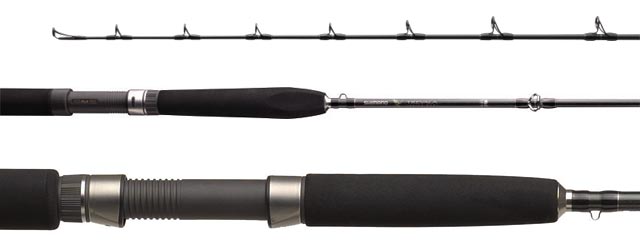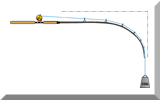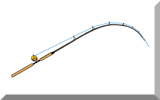Do You Need a
Specialist Jig Rod
What you're looking for in a jig rod is light weight - it's hard work jigging - plus power in the lower sections with fast action in the tip.
Your usual boat rod can be used for this, but it won't perform anything like as well as a purposely designed jigging rod.
You need to be able to lift the jig fast - not just bend the rod - then let it flutter back down.
And when a fish hits, it won't be a delicate nibble, it will be a major offensive.
If it's a good fish you'll need to hang on - more than once I've seen a jigging rod slammed down onto the gunwales before the angler's had a chance to do anything about it.
Jig rods can be marked with the either the lure weight range or the line class, but I think the weight classification is the more useful of the two...
Light, Medium or Heavy Jigging
- 3oz to 7oz ~ For general jigging in moderate depths, with medium weight jigs
- 7oz to 15oz ~ For use with hi-speed deep-drop jigs, over deep water wrecks and reefs (more than 100ft/30m) where cod, coalfish, bass or grouper will be your quarry.
- Over 15oz ~ This is really heavy territory, pirks of 500gr or more, often with a string of muppets above it.
And the Line
Your jigging rod should be designed for use with braid lines, and as casting isn't involved in vertical jigging, a conventional reel (multiplier) - ideally a lever drag model, or maybe a line-counter - will be your first choice.
Why braid line Well, the jig needs to descend as fast as possible if it's to attract the fish as much on the way down as it does on the way up. Braid line will encourage it to because of its low water resistance and its almost total lack of stretch.
And similarly, on the upstroke the jig needs to move just as soon as you sweep up with the rod - and it won't with stretchy mono line.
So braid line it is then.
What to look for in a Jig Rod
- First, it must be light or your arms will eventually fall off. This means that the rod blank will be carbon, not fibreglass as many general purpose boat rods are.
- Length should be between 6ft to 7ft - any longer and it will be tiring to use.
- The best jigging rods will be fast taper to give a proper tip action to effectively work heavy lures far beneath the boat, and after a hookup, they must deliver enough muscle to bring stubborn fish up from the depths.
|
|
- The rod rings must be suitable for braid line, which means they'll be ceramic lined to avoid the risk of grooving. Look for rings lined with Silicon Carbide (SiC), Silicon Nitride or Ziconium. You may have to pay a little extra for rod rings of the very highest quality, such as those made by Fuji or Seymo - but it's worth it.
|



